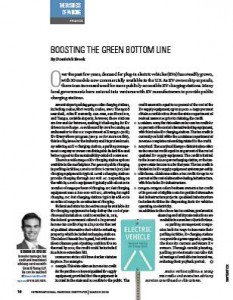Over the past few years, demand for plug-in electric vehicles (EVs) has steadily grown, with 10 models now commercially available in the U.S. As EV ownership expands, there is an increased need for more publicly-accessible EV charging stations. Many local governments have entered into ventures with EV manufacturers to provide public charging stations.
Several airport parking garages offer charging stations, including Dallas/Fort Worth, Dulles, BWI Thurgood Marshall, John F. Kennedy, San Jose, San Francisco, and Tampa. Outside airports, however, these stations are few and far between, making it challenging for EV drivers to recharge. As evidenced by IPI’s becoming an ambassador to the U.S. Department of Energy’s (DoE) EV Everywhere program (see p. 56 for more on this), this is a big issue for the industry and its professionals. By offering an EV charging station, a parking management company or owner can distinguish its facilities and better appeal to the sustainability-minded consumer.
There is a wide range of EV charging station options available in the marketplace. For general public charging in parking facilities, Level 2 or direct-current (DC) fast charging equipment is typical. Level 2 charging stations provide charging through 208 volt AC. Depending on the vehicle, Level 2 equipment typically adds about 10 to 20 miles of range per hour of charging. DC fast charging equipment uses a 300-500 volt DC, allowing for rapid charging. DC fast charging stations typically add 60 to 80 miles of range in 20 minutes of charging.
Federal and state tax incentives may be available for EV charging equipment to help defray the cost of purchase and installation. Until December 31, 2011, the federal government offered a 30 percent income tax credit of up to $30,000 for the cost of qualified alternative fuel vehicle refueling property, which included recharging stations. The federal benefit has lapsed, but with President Obama’s goal of putting 1 million EVs on the road by 2015, the credit could be included in a future extenders bill.
Numerous states still have similar statutes in place. For example:
Georgia. This state offers an income tax credit for the purchase or lease of qualified EV supply equipment, provided that the equipment is located in the state and accessible to the public. The credit amount is equal to 10 percent of the cost of the EV supply equipment, up to $2,500. A taxpayer must obtain a certification from the state Department of Natural Resources prior to claiming the credit.
Louisiana. Here, the state offers an income tax credit for 50 percent of the cost of alternative fueling equipment, which includes EV charging stations. The tax credit is currently on hold while the Louisiana Department of Revenue completes rulemaking related to the credit.
Maryland. The Maryland Energy Administration offers an income tax credit equal to 20 percent of the cost of qualified EV supply equipment. The credit is limited to the lesser of $400 per recharging station, or the taxpayer’s state income tax for that year. The tax credit is limited to 30 EV supply equipment systems per entity.
Oklahoma. Oklahoma offers a tax credit for up to 75 percent of the cost of alternative fueling infrastructure, which includes EV infrastructure.
Oregon: Oregon offers business owners a tax credit of 35 percent of eligible costs for qualified alternative fuel infrastructure projects. Qualified infrastructure includes facilities for dispensing fuels for vehicles operating on electricity.
In addition to the above tax incentives, preferential financing and utility rate reductions are available in a number of jurisdictions.
As parking management companies look for ways to innovate their parking facilities, EV charging stations can provide a green upgrade, opening the door for current and future EV owners. Through careful planning, parking professionals can take full advantage of available tax incentives, reducing their payback period.
Jessica Verhotz of Ernst & Young Tax Credits and Incentives Advisory Services contributed to this column.
Dominick Brook is senior manager, tax credit and investment advisory services with Ernst & Young LLP. He can be reached at Dominick.Brook@ey.com or 614.232.7376
TPP-2013-03-Boosting The Green Bottom Line

